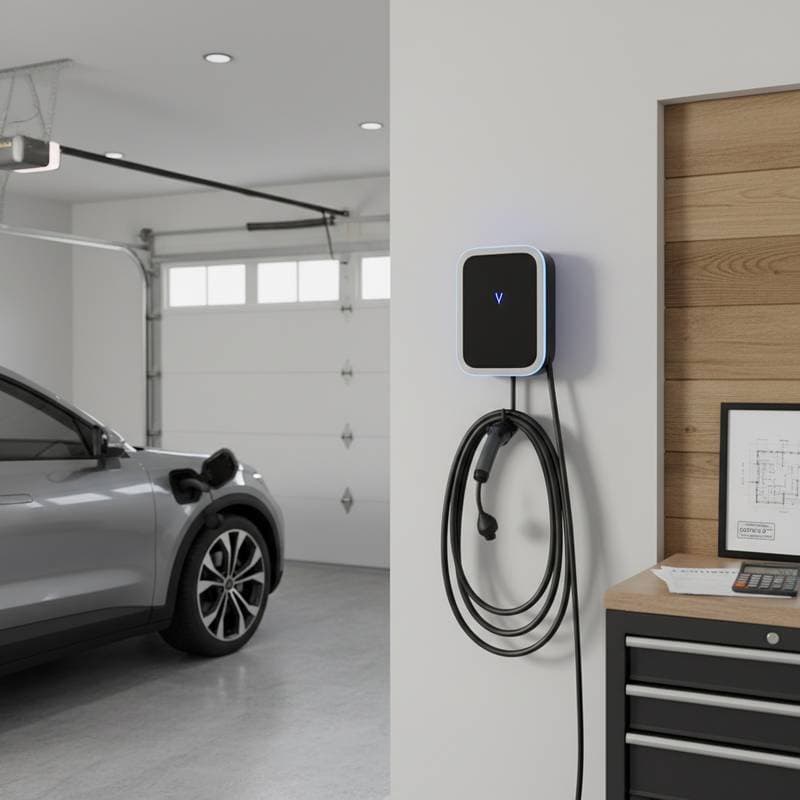Increase Home Value by 15 Percent with EV Chargers by 2025
Home EV chargers typically add 10 to 15 percent to property value in regions with strong electric vehicle adoption. Property owners who install one today prepare their homes for incoming buyers seeking modern, sustainable features. This upgrade not only enhances appeal but also aligns with broader shifts toward electrification.
Key Cost Factors
The cost of EV charger installation varies based on charger type, electrical capacity needs, and local permit requirements. Several elements influence the total expense. Homeowners should evaluate these to develop an accurate budget.
Charger Type
Level 1 chargers connect to standard outlets and range from $300 to $600 for basic models. Level 2 chargers demand a dedicated 240-volt circuit, with equipment prices between $500 and $1,200. Level 2 options provide faster charging and greater long-term value.
Electrical Upgrades
Properties with outdated electrical panels often require service upgrades costing $800 to $2,000. These improvements guarantee safe and reliable power supply. Electricians assess panel capacity during initial consultations.
Labor and Permits
Professional labor for installation spans $400 to $1,000, influenced by the distance from the main panel to the installation site. Permits contribute $50 to $200, with higher fees possible in urban or coastal zones. Early permit checks prevent delays.
Mounting and Conduit
Wall-mounted units prove more affordable than pedestal installations. Additional costs of $100 to $300 arise for trenching or conduit through existing walls. Select mounting based on parking layout and aesthetic preferences.
Add-On Features
Smart chargers equipped with Wi-Fi connectivity or load-balancing capabilities add $200 to $500 to the price. These features reduce energy expenses over time through optimized charging schedules. Integration with home automation systems further enhances efficiency.
Allocate an additional 10 to 15 percent of the budget for unforeseen issues, particularly in older homes with unupdated panels or wiring. Consult multiple quotes to identify cost-saving opportunities.
Planning and Installation Steps
Effective planning ensures smooth installation and minimizes expenses. Follow these sequential steps to prepare adequately.
-
Assess Electrical Capacity
Measure the distance from the electrical panel to the intended parking area. Shorter distances reduce wiring costs. Verify breaker size to ensure sufficient capacity. If the panel approaches full load, explore load management solutions with a licensed electrician. -
Select Charger and Mounting
Choose between wall or pedestal mounting based on site conditions. Review compatibility with current and future electric vehicles. Factor in weather exposure for outdoor placements. -
Secure Quotes and Permits
Obtain estimates from at least two licensed electricians. Confirm local permit requirements and apply early. Inquire about rebate eligibility through utility providers or government programs. -
Install and Test the System
Disconnect the main power supply prior to any circuit work. Securely mount the charger to a stud or masonry base. Route conduit away from moisture sources. Clearly label the dedicated breaker. Conduct voltage and grounding tests before initial use. Activate ground-fault protection to mitigate shock hazards.
Schedule installation during favorable weather to avoid complications. Document the process for future reference and resale documentation.
DIY Installation Versus Professional Services
Homeowners weigh DIY approaches against professional hires based on project complexity and personal expertise.
Suitable DIY Tasks
DIY suits simple Level 1 setups using existing outlets. Tasks include mounting the charger bracket or installing surface conduit under professional oversight. Intermediate skill levels suffice for these, provided individuals handle tools confidently without engaging live wiring.
Risks remain low for voltage exposure, though improper setups may invalidate warranties. Always prioritize safety protocols.
Essential Professional Involvement
Engage professionals for Level 2 installations requiring new circuits or breaker modifications. They handle trenching, panel adjustments, and code inspections. Properties with aluminum wiring or outdated systems demand expert attention.
Licensed electricians uphold compliance, proper grounding, and appropriate amperage. Indicators of underlying issues include panel buzzing, double-tapped breakers, or corrosion, all of which signal fire risks under load. Address these immediately to prevent hazards.
Maintenance and Warranty Considerations
Regular upkeep extends charger longevity and preserves performance.
Lifespan Expectations
Quality chargers endure 8 to 10 years under normal conditions. Connectors and internal relays represent common failure points, exacerbated by exposure to weather or moisture. Position units to shield from direct elements.
Ongoing Maintenance Practices
Examine cables monthly for frays or damage. Employ surge protectors in areas prone to power fluctuations. Clean vents and exteriors with a dry cloth. Update firmware on smart models to ensure compatibility with evolving vehicle standards.
Warranty Details
Manufacturers provide 3 to 5 years of coverage, with options for extensions. Ensure installers register the unit promptly. Verify compatibility if integrating with solar panels or home energy systems, as overlaps may affect terms.
Emerging Market Trends
Electric vehicle ownership expands as manufacturers introduce diverse models. Municipalities offer incentives for residential charging setups. New constructions increasingly feature pre-wired garages, establishing EV readiness as a baseline expectation. Utilities encourage smart chargers to manage grid loads effectively.
Homes lacking these amenities risk appearing obsolete, much like properties without broadband infrastructure in prior decades.
Variations by Region
Urban settings see demand for shared or individual chargers in condos and townhouses. Suburban buyers favor garages equipped for dual chargers. Rural areas experience modest value increases, bolstered by advancing vehicle ranges.
EV-ready features enhance marketability everywhere, demonstrating forward-thinking property management.
Safety Protocols and Regulatory Compliance
Adhere to rigorous safety measures throughout the process.
- Disconnect main power at the breaker prior to wiring.
- Wear insulated gloves and safety glasses.
- Maintain a fire extinguisher rated for electrical fires nearby.
- Verify voltage absence before handling wires.
- Utilize outdoor-rated conduit and fittings for external installations.
- Restrict high-voltage circuit connections to licensed electricians.
Permits become necessary for new circuits, trenching, or panel alterations. Select chargers certified by UL or equivalent standards. Compliance safeguards occupants and upholds property value.
Steps to Implement Your EV Charger
- Evaluate the electrical panel for available breaker space.
- Determine the appropriate charger type and mounting style.
- Request quotes from licensed electricians and review permits.
- Pursue rebates via utilities or energy programs.
- Arrange installation during optimal weather conditions.
- Record all details for warranty activation and resale evidence.
Perform monthly tests post-installation and track energy consumption. Present this information to prospective buyers to underscore reliability and savings. An EV charger investment delivers energy benefits alongside a competitive edge in the housing market. Initiate planning promptly to stay ahead of local trends.











